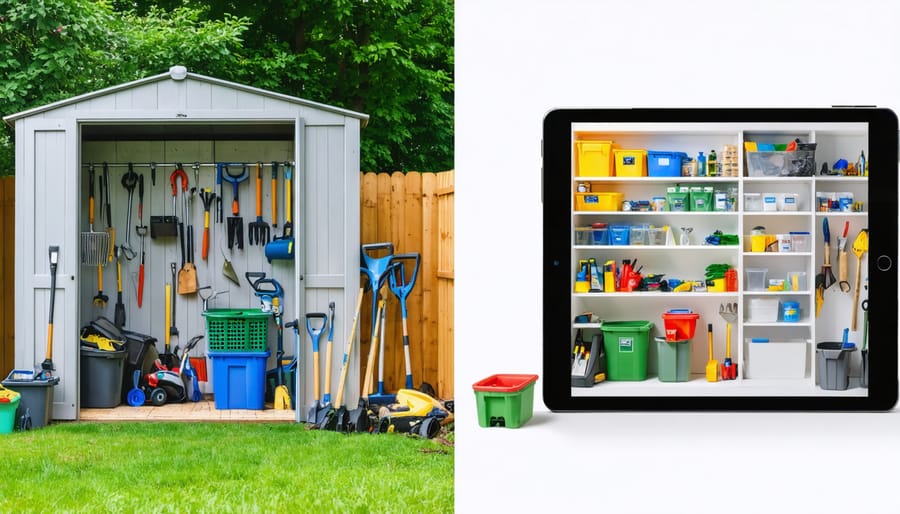Make Your Shed Storage Smart: A Modern Yard Management System That Actually Works

Transform your outdoor storage chaos into a streamlined system by implementing a smart yard management solution. Starting with a thorough inventory audit, organize a shed effectively by categorizing items into seasonal, frequently used, and long-term storage zones. Modern yard management systems combine digital tracking tools with physical organization methods to create an efficient, accessible outdoor space that saves time and reduces frustration.
Digital tracking apps paired with weather-resistant labels help maintain an accurate inventory of garden tools, seasonal decorations, and maintenance equipment. Smart storage solutions, including vertical organizing systems and modular shelving units, maximize available space while keeping items visible and easily accessible. This systematic approach transforms cluttered sheds and outdoor storage areas into well-organized spaces that enhance property value and improve daily functionality.
Real homeowners report saving up to 30 minutes per gardening session simply by implementing these organized storage solutions. Whether managing a single shed or multiple outdoor storage areas, an effective yard management system creates a sustainable, stress-free approach to maintaining outdoor equipment and supplies.
What Makes a Modern Yard Management System Different
Digital vs. Traditional Inventory Tracking
Gone are the days of clipboards and messy paper logs scattered around your shed. While traditional methods of tracking items with pen and paper might seem simpler at first, implementing a digital inventory tracking system can save you countless hours and headaches in the long run.
Digital solutions offer real-time updates, searchable databases, and the ability to access your inventory from anywhere using your smartphone. Imagine quickly finding your gardening tools or holiday decorations with just a few taps, rather than rifling through old notebooks or trying to remember where you last saw them.
Traditional methods are prone to human error, weather damage, and can be easily misplaced. Digital tracking, on the other hand, automatically backs up your data and can even send reminders when it’s time to maintain equipment or restock supplies. Plus, many apps now include photo capabilities, letting you snap pictures of items for easy visual reference.
For those worried about technology, modern inventory apps are designed with user-friendly interfaces that make the transition from paper to digital surprisingly smooth and stress-free.

Core Features Every System Should Have
A well-designed yard management system should include several key features to make your outdoor storage space truly functional. First, a clear inventory tracking method helps you know exactly what’s stored where, saving precious time when you need to find specific items. Consider using a simple labeling system with weatherproof tags or a digital checklist on your phone.
Good lighting is essential, both natural and artificial. Install windows or skylights where possible, and add battery-operated LED lights for darker corners. Proper ventilation prevents moisture buildup and protects your stored items from mold and rust.
Organized zones are crucial – create dedicated areas for gardening tools, seasonal decorations, and frequently used items. Include adjustable shelving and wall-mounted storage solutions to maximize vertical space. Weather protection features like proper insulation and weatherstripping around doors and windows will keep your belongings safe and dry.
Don’t forget about security elements such as sturdy locks and perhaps a simple camera system. Finally, ensure good accessibility with clear pathways and easy-to-open doors that can accommodate larger items when needed.
Setting Up Your Yard Management System
Initial Organization and Categorization
Before you can effectively transform your cluttered shed, start by sorting your items into clear categories. Begin with four basic groups: frequently used items, seasonal equipment, rarely used tools, and items for disposal. This initial organization makes it easier to assign dedicated spaces and maintain order long-term.
Create zones within your storage area based on usage patterns. Place everyday items like garden tools and lawn equipment near the entrance for easy access. Seasonal items such as holiday decorations or winter equipment can be stored toward the back. Consider vertical space by installing wall-mounted organizers for frequently used tools.
Use clear, weather-resistant bins with labels for smaller items, and group similar items together. For example, keep all your gardening supplies in one section, including tools, seeds, and plant food. Hardware items like nails, screws, and brackets should have their own designated area, preferably in smaller compartmented containers.
Color-coding can make your system even more effective. Assign different colored labels or bins to various categories – green for garden supplies, red for power tools, blue for hand tools. This visual organization method helps everyone in the household maintain the system and quickly locate items when needed.
Remember to leave clear pathways between storage zones and ensure heavy items are stored at waist height for safe handling. Regular maintenance of this system will keep your outdoor storage spaces functional and accessible throughout the year.
Creating Zones and Storage Areas
Organizing your shed into functional zones is like creating a mini warehouse for your outdoor essentials. Start by dividing your space into distinct areas based on usage frequency and item types. Create a “frequently used” zone near the entrance for tools and equipment you reach for weekly, such as lawn mowers and garden tools. This saves time and reduces the hassle of moving items around.
Designate a “seasonal” zone for items you only need during specific times of the year, like holiday decorations or pool supplies. This area can be placed toward the back of your shed since you’ll access it less often. Consider creating a dedicated workbench area if you often tackle DIY projects, complete with pegboards for hanging tools and adequate lighting.
For safety and efficiency, establish a “hazardous materials” zone for storing fertilizers, pesticides, and fuel, keeping them away from heat sources and electrical equipment. Use sturdy shelving units to maximize vertical space, and label each zone clearly with weather-resistant tags or signs.
Don’t forget to include a “sports and recreation” area for bikes, camping gear, and outdoor games. Keep these items easily accessible but protected from the elements. Remember to leave clear pathways between zones – a good rule of thumb is to maintain at least 3 feet of walking space to move items in and out comfortably.

Implementing Tracking Methods
Keeping track of your yard items doesn’t have to be complicated, and there are several effective methods to choose from based on your needs and comfort with technology. The simplest approach is using waterproof labels and tags, which work well for basic organization. Write clear descriptions with permanent markers and protect the labels with clear tape for durability against weather.
For a more structured system, consider using a color-coding method. Assign different colors to various categories – for example, green for gardening tools, blue for pool supplies, and red for power equipment. This visual system makes it easy to spot items quickly and return them to their proper places.
If you’re tech-savvy, digital solutions can transform your yard management. A simple spreadsheet on your phone can work wonders, letting you track what you have and where it’s stored. Many homeowners find success with QR code labels, which they can scan with their smartphones to access detailed item information and location data.
For those wanting a more robust solution, several user-friendly inventory apps are available. These apps often include features like photo storage, maintenance schedules, and even borrowing trackers for when neighbors request to use your tools. Some popular options allow you to create virtual zones that match your actual storage layout, making it easier to maintain organization over time.
Remember, the best tracking method is one you’ll actually use consistently, so choose a system that matches your lifestyle and technological comfort level.
Maintaining Your System Year-Round
Seasonal Updates and Adjustments
As seasons change, your yard management system needs to adapt to maintain its efficiency and protect your belongings. Creating year-round storage solutions starts with seasonal adjustments that keep your system working smoothly.
In spring, focus on moisture control by adding dehumidifiers and ensuring proper ventilation. Relocate winter equipment to the back of storage areas and bring gardening tools forward for easy access. Consider installing weather stripping around doors to prevent spring rain from seeping in.
Summer calls for heat management strategies. Add reflective materials or proper insulation to protect temperature-sensitive items. Create dedicated spaces for frequently used summer equipment like lawn mowers and pool supplies near the entrance. Install battery-operated fans if needed to improve air circulation.
Fall preparation involves reorganizing for upcoming cold weather. Move summer items to secondary storage positions and bring winter equipment forward. Check weatherproofing and seal any gaps that could let in autumn leaves or moisture. Add hooks for storing wet weather gear.
Winter requires the most protective measures. Install foam pipe covers on any exposed plumbing, add extra insulation where needed, and ensure proper drainage around your storage area. Keep snow removal equipment easily accessible and store sensitive items on elevated platforms to protect from potential flooding during snow melt.
Remember to inspect and maintain your organizational system during each transition, replacing any damaged storage solutions and updating labels as needed.

Regular Maintenance Checks
Keeping your yard management system running smoothly requires regular maintenance checks. Create a monthly schedule to inspect your storage units, organization systems, and inventory tracking tools. Start by examining all door hinges, locks, and weatherstripping, ensuring they’re functioning properly and free from rust or damage.
Check your shelving units and storage containers quarterly for stability and signs of wear. Look for any loose screws, warped boards, or damaged bins that might need replacement. If you’re using digital tracking systems or apps, back up your data monthly and update any software when prompted.
Seasonal maintenance is crucial for protecting your stored items. Before winter, inspect roof seals and drainage systems to prevent water damage. In spring, check for any pest intrusions and seal entry points. Summer calls for ventilation system checks to maintain proper airflow, while fall is perfect for organizing and decluttering.
Create a simple checklist including:
– Door and lock functionality
– Shelf and container integrity
– Digital system updates
– Weather protection measures
– Pest prevention
– Inventory accuracy check
– Storage layout efficiency
Set reminders on your phone or calendar for these maintenance tasks. Quick, regular checks prevent major issues and keep your yard management system working effectively year-round. Remember, a well-maintained system saves time and protects your valuable items from damage or loss.
Real-World Success Stories
Meet Sarah Thompson from Colorado, who transformed her cluttered backyard into an organized oasis. After years of struggling with scattered gardening tools and sports equipment, she implemented a zone-based yard management system that revolutionized her storage space. “I divided my shed into three distinct areas: gardening, seasonal items, and sports equipment. Using clear bins and labels, I can now find everything in seconds,” Sarah shares.
In Texas, the Martinez family tackled their outdoor storage challenges by installing a modular shelving system in their shed. “With four kids involved in different activities, our yard was chaos,” explains Carlos Martinez. “We created a color-coded system where each family member has their designated storage space. The difference is night and day.”
Robert Chen, a retired teacher from Oregon, implemented a innovative rotating seasonal storage solution. “I installed sliding shelves that allow me to push winter items to the back during summer and vice versa,” he says. “This system has eliminated the twice-yearly storage shuffle that used to take entire weekends.”
Perhaps the most impressive transformation comes from the Williams family in Michigan. They converted their traditional shed into a smart storage hub by installing motion-sensor lights and a simple inventory app. “We attached QR codes to our storage bins,” explains Lisa Williams. “One quick scan tells us exactly what’s inside without opening anything. It’s especially helpful during the holidays when searching for decorations.”
These success stories share common elements: clear organization systems, labeled storage solutions, and designated spaces for specific items. Each homeowner adapted their yard management system to their unique needs while maintaining simplicity and accessibility. Their experiences show that with proper planning and implementation, any outdoor storage space can become efficiently managed and easily maintained.
Implementing a yard management system is one of the best investments you can make for your home’s outdoor organization. By following the guidelines and strategies we’ve discussed, you can transform a chaotic storage space into an efficient, well-organized area that saves you time and reduces stress. Homeowners who have implemented these systems consistently report feeling more in control of their outdoor equipment and tools, with many noting they’ve saved hours previously spent searching for misplaced items.
The beauty of yard management systems lies in their flexibility – you can start small and expand as needed. Whether you’re working with a compact garden shed or a larger storage space, the principles remain the same: categorize, label, and maintain. The initial effort of setting up your system will pay dividends in the long run through improved accessibility, better tool maintenance, and enhanced safety.
Remember, the perfect system is the one that works for you and your specific needs. Don’t be afraid to adjust and refine your organization method over time. Start with basic shelving and storage containers, then gradually incorporate more sophisticated solutions as you identify your specific needs.
Take the first step today by simply assessing your current storage situation and identifying one area for improvement. Small changes, consistently applied, lead to significant transformations in how you manage your outdoor space and equipment.

